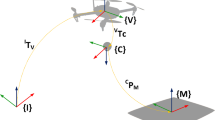Abstract
This paper presents an intelligent automatic landing system that uses adaptive fuzzy neural network controller to improve the performance of conventional automatic landing systems. Functional fuzzy rules are implemented in neural network. In this study, Lyapunov stability theory is utilized to derive adaptive learning rate in the controller design. Stability of the control system is guaranteed. Simulation results show that the fuzzy neural network controller with adaptive learning rate has better performance than PID controller in guiding aircraft to a safe landing in turbulence condition.
Access this chapter
Tax calculation will be finalised at checkout
Purchases are for personal use only
Preview
Unable to display preview. Download preview PDF.
Similar content being viewed by others
References
NASDAC Review of NTSB Weather-Related Accidents, http://www.ntsb.gov/aviation/Table10.htm
Aircraft accident statistics, http://www.planecrashinfo.com/cause.htm
Dogan, A., Kabamba, P.T.: Escaping a Microburst with Turbulence. In: Proc. American Control Conference, pp. 1349–1353 (2000)
Chen, C.Y.: Optimal Abort Landing Trajectories for a High-Angle-Of-Attack Windshear Encounter. The Chinese Journal of Mechanics 11(1), 75–81 (1995)
Buschek, H., Calise, A.J.: Uncertainty Modeling and Fixed-Order Controller Design for a Hypersonic Vehicle Model. Journal of Guidance, Control, and Dynamics 20(1), 42–48 (1997)
Federal Aviation Administration, Automatic Landing Systems. AC 20-57A (January 1971)
Cohen, C.E., et al.: Automatic Landing of a 737 Using GNSS Integrity Beacons. In: Proc. ISPA (1995)
DDC-I: Advanced Auto Landing System from Swiss Federal Aircraft Factory. Real-Time Journal, Sprint (1995)
Asai, S., et al.: Development of Flight Control System for Automatic Landing Flight Experiment. Mitsubishi Heavy Industries Technical Review 34(3) (1997)
Kaufmann, D.N., McNally, B.D.: Flight Test Evaluation of the Stanford University and United Airlines Differential GPS Category III Automatic Landing System. NASA Technical Memorandum 110354 (June 1995)
Malaek, S.M.B., Sadati, N., Izadi, H., Pakmehr, M.: Intelligent Autolanding Controller Design Using Neural Networks and Fuzzy Logic. In: Proc. IEEE 5th Control Conference, vol. 1, pp. 365–373 (2004)
Izadi, H., Pakmehr, M., Sadati, N.: Optimal Neuro-Controller in Longitudinal Autolanding of a Commercial Jet Transport. In: Proc. IEEE International Conference on Control Applications, pp. 1–6 (2003)
Chaturvedi, D.K., Chauhan, R., Kalra, P.K.: Application of Generalized Neural Network for Aircraft Landing Control System. Soft Computing 6, 118–441 (2002)
Iiguni, Y., Akiyoshi, H., Adachi, N.: An Intelligent Landing System Based on Human Skill Model. IEEE Transactions on Aerospace and Electronic Systems 34, 877–882 (1998)
Ionita, S., Sofron, E.: The Fuzzy Model for Aircraft Landing Control. In: Proc. AFSS International Conference on Fuzzy Systems, pp. 47–54 (2002)
Nho, K., Agarwal, R.K.: Automatic Landing System Design Using Fuzzy Logic. Journal of Guidance, Control, and Dynamics 23, 298–304 (2000)
Jorgensen, C.C., Schley, C.: A Neural Network Baseline Problem for Control of Aircraft Flare and Touchdown. Neural Networks for Control, 403–425 (1991)
Juang, J.G., Chang, H.H.: Application of Time Delay Neural Network to Automatic Landing Control. In: Proc. of IEEE International Conference on Control Applications, vol. 1, pp. 150–155 (2002)
Lee, C.H., Teng, C.C.: Identification and Control of Dynamic Systems Using Recurrent Fuzzy Neural Networks. IEEE Trans. Fuzzy Sets and Systems 8(6) (August 2000)
Chin, K.C., Juang, J.G.: Application of Functional Fuzzy Neural Network to Aircraft Automatic Landing Control in Turbulence Condition. In: Proc. of Joint Conference on Fuzzy Systems and Grey Systems, A117 (2003) (in Chinese)
Author information
Authors and Affiliations
Editor information
Editors and Affiliations
Rights and permissions
Copyright information
© 2010 Springer-Verlag Berlin Heidelberg
About this paper
Cite this paper
Juang, JG., Chien, LH. (2010). Adaptive Fuzzy Neural Network Control for Automatic Landing System. In: Pan, JS., Chen, SM., Nguyen, N.T. (eds) Computational Collective Intelligence. Technologies and Applications. ICCCI 2010. Lecture Notes in Computer Science(), vol 6421. Springer, Berlin, Heidelberg. https://doi.org/10.1007/978-3-642-16693-8_53
Download citation
DOI: https://doi.org/10.1007/978-3-642-16693-8_53
Publisher Name: Springer, Berlin, Heidelberg
Print ISBN: 978-3-642-16692-1
Online ISBN: 978-3-642-16693-8
eBook Packages: Computer ScienceComputer Science (R0)




